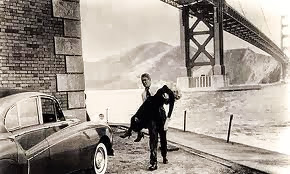Quentin Tarantino has been working on this World War II script for many years, and what is ostensibly a revenge film with moments of terrific dialogue and parallel subplots is a bit undone with untidy displays of violence and a fantasy denouement. Nevertheless, the play is the thing and few writer/directors could fashion such an entertaining if mean spirited film like Inglourious Basterds with bravura performances particularly by Christoph Waltz as a most charming and lethal Nazi.
Once upon a time during World War II a French man is questioned about the whereabouts of local French Jews by a polite German SS officer, Colonel Hans Landa (Christoph Waltz) whose silky, sinister approach gets remarkable, deadly results from which one teenage French girl barely escapes.
Next we meet Lt. Aldo Raine (Brad Pitt giving a Chad Everett by way of Clark Gable impression) who has recruited Jewish soldiers to hunt down and terrorize the Nazis in an Apache Indian way. Any survivors do not escape unscathed but have a Swastika cross carved into their foreheads, their mark for life.
In 1944, a young French woman, Emmanuelle, owns a movie theater and is wooed by a German war hero, Fredrick, whose film, Nation’s Pride, is premiering in Paris. Fredrick gets Joseph Goebbels, head of German Propaganda to move the premiere to Emmanuelle’s smaller theater. She is in fact the young French girl (Shosanna) who escaped a massacre and is plotting to take revenge by killing all the Nazi attendees.
At the same time, British Lt. Archie Hicox is sent to meet a double agent in France and, with Raine’s men, attend the Nation’s Pride premiere to blowup the theater and kill high level Nazis including Hitler. Hicox meets the agent who is a famous German actress, Bridget von Hammersmark (Diane Kruger is glamorous) in a basement cafe. German soldiers and an SS officer complicate things, and a Mexican standoff ensues with explosive results. Having to alter plans, Raine substitutes himself and the surviving Basterds into the mission.
At the premiere, as head of security, Col. Landa discovers the Allied plot, and Raine is arrested and interrogated in another building. There, Landa makes a startling proposal even as Emmanuelle plots to ignite the film nitrate stored in her theater and the other ‘basterds’ in the audience execute their part of the plan. Seemingly spared the finale at the theater and having manipulated his own fate, Col. Landa and Lt. Raine have a day of reckoning.
The usual Tarantino touches are here including excruciating scenes with gunshots, scalpings, stabbings, and bat beatings. The film is structured in five chapters, and his love for movies is evident in references to German cinema icons, and, no doubt, major filmic influences from The Dirty Dozen (especially in the recruitment scene and the high octane finale), Where Eagles Dare, and any number of spaghetti westerns. Imaginative use is made of fluid camera movement and rapid edits.
While the cast is in fine form with Til Schweiger as a Charles Bronson-type, director Eli Roth as the Bear Jew, and Mélanie Laurent, radiant as the haunted Emmanuelle, the standout is Waltz. Pitt is a hoot as Raine (whose name is a play on actor Aldo Ray), and when he tries to spout Italian phrases, it is outrageous. Veteran Rod Taylor and comedian Mike Myers have fleeting cameos.
Some criticism of the film is warranted. Infamous figures get killed at the premiere; if you are going to rewrite history even in a fable, don’t take something that is so ingrained as to make an utter mockery of it. Also, any sympathetic characters pretty much go out the window, so don’t get too attached to anyone.
No Tarantino film would be complete without wonderfully written set pieces especially the one in the basement café that is very reminiscent of the final standoff in Reservoir Dogs. While his words are sublime and he is adept at setting up such scenes, he does not take full advantage of the possibilities of others which are given relatively short shrift like the arrest of Raine and the confrontation of Bridget by Col. Landa.
For fans of the talented director, this one is a must, but for the average moviegoer, the snappy screenplay may not be fully appreciated in the overall context of an entertaining story that drips a bit too much blood. Two things are for sure: A glass of milk will never seem the same again, and Brad Pitt looks fabulous in a white tuxedo.
*** of **** stars (add ½ star for Tarantino fans)
Nominated for Best Picture 2009






